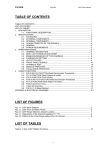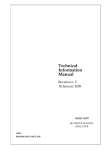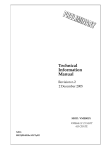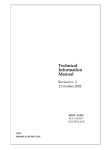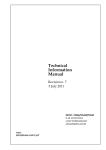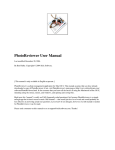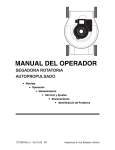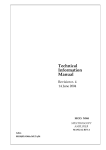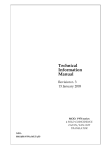Download Technical Information Manual
Transcript
Technical Information Manual Revision n. 5 7 November 2002 MOD. N842-N843 8-16 CHANNEL CONSTANT FRACTION DISCRIMINATOR NPO: 00103/00:842-3.MUTx/05 CAEN will repair or replace any product within the guarantee period if the Guarantor declares that the product is defective due to workmanship or materials and has not been caused by mishandling, negligence on behalf of the User, accident or any abnormal conditions or operations. CAEN declines all responsibility for damages or injuries caused by an improper use of the Modules due to negligence on behalf of the User. It is strongly recommended to read thoroughly the CAEN User's Manual before any kind of operation. CAEN reserves the right to change partially or entirely the contents of this Manual at any time and without giving any notice. Document type: User's Manual (MUT) Title: Mod. N842-N843 8-16 Channel Constant Fraction Discriminator Revision date: 07/11/2002 Revision: 5 TABLE OF CONTENTS 1. 2. GENERAL DESCRIPTION....................................................................................................................................4 1.1. FUNCTIONAL DESCRIPTION ..................................................................................................................................4 1.2. BLOCK DIAGRAM .................................................................................................................................................5 TECHNICAL SPECIFICATIONS .........................................................................................................................6 2.1. PACKAGING .........................................................................................................................................................6 2.2. POWER REQUIREMENTS .......................................................................................................................................6 2.3. FRONT AND BACK PANEL .....................................................................................................................................7 2.4. INPUT/OUTPUT CONNECTIONS .............................................................................................................................8 2.4.1. INPUT features ...........................................................................................................................................8 2.4.2. OUTPUT features .......................................................................................................................................8 2.5. OTHER COMPONENTS ...........................................................................................................................................9 2.5.1. Displays ......................................................................................................................................................9 2.5.2. Front panel switches ...................................................................................................................................9 2.5.3. Rotary handle..............................................................................................................................................9 2.5.4. Jumpers.......................................................................................................................................................9 2.6. 3. TECHNICAL SPECIFICATION TABLE ....................................................................................................................11 OPERATING MODES ..........................................................................................................................................12 3.1. THE CONSTANT FRACTION DISCRIMINATION TECHNIQUE .................................................................................12 3.2. POWER ON STATUS ...........................................................................................................................................12 3.3. SETTING THE DELAY ..........................................................................................................................................12 3.4. BACK PANEL SIGNALS........................................................................................................................................12 3.5. SETTING THE THRESHOLD AND DISABLING THE CHANNELS................................................................................13 3.6. SETTING THE OUTPUT PULSE WIDTH ..................................................................................................................13 3.7. SETTING THE DEAD TIME ..................................................................................................................................14 LIST OF FIGURES FIG. 1.1: MOD. N843 BLOCK DIAGRAM (16 CHANNEL)..................................................................................................5 FIG. 2.1: MOD. N843-N842 FRONT PANEL AND BACK PANEL ..........................................................................................7 FIG. 2.2: JUMPERS LOCATION ........................................................................................................................................10 LIST OF TABLES TABLE 2.1: POWER REQUIREMENTS .................................................................................................................................6 TABLE 2.2: TECHNICAL SPECIFICATION TABLE ..............................................................................................................11 NPO: 00103/00:842-3.MUTx/05 Filename: n842n843_rev5.doc Number of pages: 14 Page: 3 Document type: User's Manual (MUT) Title: Mod. N842-N843 8-16 Channel Constant Fraction Discriminator Revision date: 07/11/2002 Revision: 5 1. General description 1.1. Functional description The CAEN Model N843 is a 16 CHANNEL CONSTANT FRACTION DISCRIMINATOR housed in a single width NIM module. The module accepts 16 negative inputs and produces 16 NIM outputs + 16 /NIM outputs (complementary) on 48 front panel LEMO 00 connectors (NIM outputs are provided with a Fan-Out of two); a functional block diagram is shown in Fig. 1.1. A 8 Channel version, the CAEN Model N842, sharing the same functional features with the 16 Channel Model N843, is also available. The constant fraction delay is defined by a delay line network of 20 ns with 5 taps (see fig. 2.2). The timing stage of the discriminator produces an output pulse whose width is adjustable in a range from 18 ns to 318 ns. Moreover, in order to protect against multiple pulsing, it is possible to program a Dead Time during which the discriminator is inhibited from retriggering. The maximum time walk is ±400 ps (for input signals in the range from -50 mV to -5 V with 25 ns rise time). The constant fraction is 20%. The individual discriminating thresholds are settable in a range from -1 mV to -255 mV (1 mV step) via an 8-bit DAC. The module can operate also with small (below 10 mV) input signals, though in this case the Constant Fraction operation is not performed, i.e. the jitter is higher. The channels’ threshold, output width and dead time can be programmed via two switches and one rotary handle placed on the front panel. The back panel houses VETO and TEST inputs, the logical OR output (the relevant “OR” LED lights up if at least one channel is over threshold) and the Current Sum (Σ) output, which generates a current proportional to the input multiplicity, i.e. to the number of channels over threshold, at a rate of -1.0 mA per hit (-50 mV per hit into a 50 Ohm load) ± 20%. NPO: 00103/00:842-3.MUTx/05 Filename: n842n843_rev5.doc Number of pages: 14 Page: 4 Document type: User's Manual (MUT) Title: Mod. N842-N843 8-16 Channel Constant Fraction Discriminator Revision date: 07/11/2002 Revision: 5 1.2. Block diagram DACs,TEST, INHIBIT W LOGIC ........................ 8 bit DAC DT 0:7 8 bit 8 bit 8 bit 8 bit 8 bit 8 bit 8 bit DAC DT 8:15 DAC WTH 0:7 DAC WTH 8:15 DAC DAC .................. DAC DAC ch.0 ch.1 ch.15 ch14 inhibit THRESHOLDS, WIDTH AND DEAD TIME C.P.U. INPUTS<0..15> Σ discr. discr. ch.0 ch.1 ................. discr. ch.14 discr. ch.15 TEST OR LED VETO DISPLAY OUTPUTS<0..15> A, B OR OUT Fig. 1.1: Mod. N843 Block Diagram (16 Channel) NPO: 00103/00:842-3.MUTx/05 Filename: n842n843_rev5.doc Number of pages: 14 Page: 5 Document type: User's Manual (MUT) Title: Mod. N842-N843 8-16 Channel Constant Fraction Discriminator Revision date: 07/11/2002 Revision: 5 2. Technical Specifications 2.1. Packaging The Model N842-N843 is housed in a 1U-wide NIM unit. 2.2. Power requirements The power requirements of the Mod. N842-N843 are as follows: Table 2.1: Power requirements Power Supply + 12 V - 12 V +6V - 6V NPO: 00103/00:842-3.MUTx/05 Filename: n842n843_rev5.doc N842 40 mA 30 mA 500 mA 1.8 A N843 60 mA 30 mA 1.1 A 3.4 A Number of pages: 14 Page: 6 Document type: User's Manual (MUT) Title: Mod. N842-N843 8-16 Channel Constant Fraction Discriminator Revision date: 07/11/2002 Revision: 5 2.3. Front and back panel Mod. N842 Mod. N843 16 CH CFD 8 CH CFD INPUT INPUT 0 1 2 3 4 5 6 7 8 9 12 10 13 14 0 1 2 3 4 5 6 7 11 15 OUTPUT 0 1 2 3 0 1 2 3 0 1 2 3 4 5 6 7 4 5 6 7 5 6 7 4 2 8 9 10 11 8 9 10 11 8 9 10 11 12 13 14 15 12 13 14 15 12 13 14 15 OUTPUT 0 1 0 1 2 3 2 3 4 5 4 5 6 7 6 7 OR OR THR DT WDT THR DT WDT LCK T E S T O R SEL SET V E T O SEL SET LCK Fig. 2.1: Mod. N843-N842 front panel and back panel NPO: 00103/00:842-3.MUTx/05 Filename: n842n843_rev5.doc Number of pages: 14 Page: 7 Document type: User's Manual (MUT) Title: Mod. N842-N843 8-16 Channel Constant Fraction Discriminator Revision date: 07/11/2002 Revision: 5 2.4. Input/Output connections The location of the Mod. N842-N843 connectors is shown in Fig. 2.1. Their function and electromechanical specifications are listed in the following subsections and are referred to the Mod. N843 (the Mod. N842 features specified between [ ] ). 2.4.1. INPUT features INPUT CHANNELS: Mechanical specifications: 16 [8] LEMO 00 type connectors. Electrical specifications: negative polarity, 50 Ohm impedance; minimum ratings: -5 mV; maximum ratings: -5 V. VETO INPUT: Mechanical specifications: 2 bridged LEMO 00 type connectors. Electrical specifications: standard NIM signal, high impedance, 15 ns minimum FWHM; leading edge of the VETO signal must precede of at least 10 ns the leading edge of the input and overlap completely the input signal; acts on all signals. TEST INPUT: Mechanical specifications: 2 bridged LEMO 00 type connectors. Electrical specifications: standard NIM signal, high impedance, 5 ns minimum FWHM, 30 MHz Max. frequency, Test/Output delay: 10 ns. 2.4.2. OUTPUT features OUTPUT CHANNELS: Mechanical specifications: 48 [24] (32 [16] Fan-Out of two for OUT and 16 [8] single for /OUT) LEMO 00 connectors. Electrical specifications: NIM level on 50 Ohm impedance; pulse width adjustment from 18 ns to 318 ns; maximum time walk is ± 400 ps for input signals in the range from -50 mV to -5 V with 25 ns rise time. Input/Output delay: 24 ns (typical). OR OUTPUT: Mechanical specifications: 2 LEMO 00 type connectors, Fan-Out of two. Electrical specifications: standard NIM signal, 50 Ω impedance, 30 ns minimum FWHM, 25 MHz maximum frequency. NPO: 00103/00:842-3.MUTx/05 Filename: n842n843_rev5.doc Number of pages: 14 Page: 8 Document type: User's Manual (MUT) Title: Mod. N842-N843 8-16 Channel Constant Fraction Discriminator Σ OUTPUT: Revision date: 07/11/2002 Revision: 5 Mechanical specifications: 2 bridged LEMO 00 type connectors. Electrical specifications: current output (-1 mA ± 20% per hit), high impedance, 18 ns minimum FWHM, 25 MHz maximum frequency. 2.5. Other components 2.5.1. Displays The front panel hosts the following LEDs: INPUT Type: 16 [8] red LEDs Function: channel selected; they light up when the channels are being programmed (SEL mode) and when they are inhibited (LCK mode) OR Type: 1 green LED Function: it lights up if at least one output signal is present. 4 DIGIT DISPLAY Type: 4 digit red LED display Function: it indicates the channels’ status and programmed parameters’ values 2.5.2. Front panel switches UPPER SWITCH Function: it allows to select the parameter which must be programmed LOWER SWITCH Function: it allows to select the channel/block which must be programmed (SEL mode), and to “freeze” the programmed values (LCK mode) 2.5.3. Rotary handle Function: it allows to set the value of the parameter which is being programmed. 2.5.4. Jumpers DELAY JUMPERS Function: these 5-position jumpers allow to set the Delay. The Delay values range up to 20 ns with 4 ns steps (please refer to Fig. 2.2 for the jumpers location on the N842-N843 boards). Factory setting is 20 ns. NPO: 00103/00:842-3.MUTx/05 Filename: n842n843_rev5.doc Number of pages: 14 Page: 9 Document type: User's Manual (MUT) Ch7 Ch6 Title: Mod. N842-N843 8-16 Channel Constant Fraction Discriminator Ch5 Ch4 Ch3 Ch2 Ch1 Ch0 Ch15 Revision date: 07/11/2002 Ch14 Ch11 Ch10 Ch7 Revision: 5 Ch6 Ch3 Ch2 20 ns 16 ns 12 ns 8 ns 4 ns N842 FRONT FRONT 20 ns 16 ns 12 ns 8 ns 4 ns N843 Ch1 Ch0 Ch5 Ch4 Ch9 Ch8 Ch13 Ch12 N843 FRONT 20 ns 16 ns 12 ns 8 ns 4 ns Fig. 2.2: Jumpers location NPO: 00103/00:842-3.MUTx/05 Filename: n842n843_rev5.doc Number of pages: 14 Page: 10 Document type: User's Manual (MUT) Title: Mod. N842-N843 8-16 Channel Constant Fraction Discriminator Revision date: 07/11/2002 Revision: 5 2.6. Technical specification table Table 2.2: Technical specification table Features referred to Mod. N843 (Mod. N842 features specified between [ ] ) Packaging 1U-wide NIM unit 16 [8] inputs (negative polarity, 50 Ω impedance) Input channels Max. input voltage -5 V Min. detectable signal -5 mV Threshold range -1 mV to -255 mV (1 mV step) Constant fraction 20% Delay Selectable in 4 ns steps (20 ns full scale) Output channels 32 [16] NIM (Fan-Out of 2) + 16 [8] /NIM (single) (50 Ω impedance) Input/output delay 24 ns Output width Programmable from 18 ns to 318 ns Output rise/fall time OUT: 1.2 ns; /OUT: 2.5 ns Programmable from 150 ns to 2 μs (dispersion ± 10%) Dead Time Interchannel insulation 50 dB for 2.5 ns rise time input signals Max outputs time walk ±400 ps for input signals in the range from -50 mV to - 5 V with 25 ns rise time Autowalk Automatic adjustment to input offset and low frequency input noise of ±40 mV Control signals VETO IN: NIM signal, high impedance, allows vetoing of all channels simultaneously TEST IN: triggers all the enabled channels at once OR OUT: standard NIM signal, 50 Ω impedance; logic OR of outputs Σ OUT: current proportional to input multiplicity (-1 mA ± 20% per hit), high impedance NPO: 00103/00:842-3.MUTx/05 Filename: n842n843_rev5.doc Number of pages: 14 Page: 11 Document type: User's Manual (MUT) Title: Mod. N842-N843 8-16 Channel Constant Fraction Discriminator Revision date: 07/11/2002 Revision: 5 3. Operating Modes 3.1. The Constant Fraction Discrimination technique The Constant Fraction Discrimination technique is based on summing a delayed, full height input signal to an inverted and attenuated signal. The resulting signal is fed into a zero-crossing comparator, thus obtaining a precise timing information that eliminates any walk error induced by constant rise time and varying amplitude signals. For correct operation the maximum of the attenuated pulse has to cross the delayed pulse at the selected fraction. This condition leads to the following relation: Tdelay = Trise · (1 - F) where: Tdelay = selected delay on the Constant Fraction Discriminator Trise = rise time of the input signals F = Constant Fraction value The Mod. N842-N843 Constant Fraction Discriminator features a factory setting of 20% for the fraction and 20 ns for the full scale delay. The delay can be selected in 4 ns steps up to 20 ns. 3.2. Power ON Status At Power ON the values of all the module’s parameters are those programmed before the last turning off. If one parameter’s value is meaningless, the unit sets it at half of its range. 3.3. Setting the delay Each channel is provided with a 5-position jumper which allows to set the Delay according to the formula expressed in § 3.1 (see Fig. 2.2) for the jumpers location on board). The Delay values range up to 20 ns with a step of 4 ns. Factory setting is 20 ns. The fraction is a fixed 20% value. 3.4. Back panel signals Some operations can be performed via two external NIM input signals: • TEST: an input signal sent through this connector triggers all the enabled channels at once. This feature allows a complete test of the module without removing any input cable as well as it allows generation of a pattern of pulses suitable to test any following electronics. NPO: 00103/00:842-3.MUTx/05 Filename: n842n843_rev5.doc Number of pages: 14 Page: 12 Document type: User's Manual (MUT) Title: Mod. N842-N843 8-16 Channel Constant Fraction Discriminator Revision date: 07/11/2002 Revision: 5 • VETO: an input signal sent through this connector allows vetoing of all channels simultaneously. A veto pulse of width T will veto the input during this time T. Its leading edge must precede the output leading edge by at least 10 ns and overlap completely the input signal. VETO does not affect the TEST signal. Each one of these high impedance inputs is provided via two bridged connectors for daisy chaining. Note that since these are high impedance inputs, the chain has thus to be terminated on 50 Ω on the last module; the same is needed whenever one module only is used, whose inputs have thus to be properly matched Moreover the back panel houses a Current Sum (Σ) output (on two bridged connectors) which generates a current proportional to the input signal multiplicity, i. e. to the number of channels over threshold, at a rate of -1.0 mA per hit (-50 mV per hit into a 50 Ω load) ± 20%. An OR output (with a Fan-Out of two) provides the logical OR of the output channels. 3.5. Setting the threshold and disabling the channels For each channel of the N842-N843 the discriminator threshold is set up via an 8 bit DAC. The threshold values can be programmed in a range from -1 mV to -255 mV with -1 mV steps. As in all Constant Fraction Discriminators, these thresholds must be set above the noise level: they do NOT correspond to the actual level that triggers the discriminator outputs, the latter being a “constant fraction” of the input signals. In order to set the threshold the Upper Switch (see § 2.5.2) must be placed on the THR position and the Lower Switch removed from the LCK position, then the channel that must be programmed is selected pulling up repeatedly the Lower Switch (the selected channel’s Led lights up). Note that after the last channel, by pulling up the lower switch, the Leds ligth up all together and, at this point, the threshold setting is performed over all the channels (this value must be confirmed by placing the Lower Switch on the LCK position, otherwise it is ignored). The threshold value is set via the front panel Rotary handle (see § 2.5.3) and shown on the 4-Digit Display: 1 leads to a –1mV and 255 to a – 255 mV threshold value; 1 leads to a –1mV and 255 to a –255 mV threshold value; the step which follows 255 is four “*” appearing on the display (the relevant channel is inhibited), then again 0, 1, 2 etc; inhibited channels’ Leds are always lit when the lower switch is in lock (LCK) position. Once all the channels’ thresholds have been set to the desired value the Lower Switch must be placed on the LCK (lower) position and the word LOCK appears on the display. 3.6. Setting the output pulse width The output pulse width is adjustable on 8 bit from 18 to 318 ns and the chosen value is applied to a group of 8 channels each. The Mod. N843 has two groups (Ch. 0, 1, 4, 5, 8, 9, 12, 13 and Ch. 2, 3, 6, 7, 10, 11, 14, 15, respectively), the Mod. N842 has only one group. The Upper Switch must be placed on the WDT position and the Lower Switch removed from the LCK position, then the group is selected pulling up repeatedly the Lower Switch (the selected group’s Leds light up all together). The width’s value is set via the Rotary Handle and shown on the display (0 leads to a 18 ns and 255 to a 318 ns width with a non-linear relation for intermediate values); the step which follows 255 is NPO: 00103/00:842-3.MUTx/05 Filename: n842n843_rev5.doc Number of pages: 14 Page: 13 Document type: User's Manual (MUT) Title: Mod. N842-N843 8-16 Channel Constant Fraction Discriminator Revision date: 07/11/2002 Revision: 5 again 0, then 1, 2 etc. Once the Pulse Widths have been programmed the Lower Switch must be placed on the LCK position and the word LOCK appears on the display. 3.7. Setting the Dead Time It is possible to set a Dead Time value, common to a group of 8 channels. The Mod. N843 has two groups (Ch. 0, 1, 4, 5, 8, 9, 12, 13 and Ch. 2, 3, 6, 7, 10, 11, 14, 15, respectively), the Mod. N842 has only one group. This prevents the triggering of the discriminator by unwanted pulses occurring within the Dead Time programmed value. The Upper Switch must be placed on the DT position and the Lower Switch on the SEL position then the group is selected pulling up repeatedly the Lower Switch (the selected group’s Leds light up all together). The dead time value is set via the Rotary Handle. The displayed value corresponds to the Dead Time as follows: 255 leads to a 2 μs value, 0 leads to a 150 ns value with a non-linear interpolation for intermediate values; the step which follows 255 is again 0, then 1, 2 etc. Once the Dead Times have been programmed the Lower Switch must be placed on the LCK position and the word LOCK appears on the display. NPO: 00103/00:842-3.MUTx/05 Filename: n842n843_rev5.doc Number of pages: 14 Page: 14














